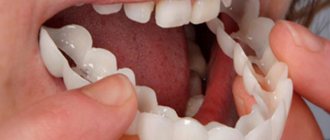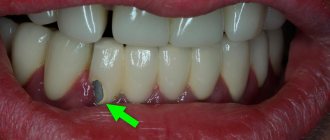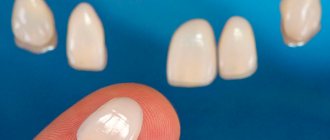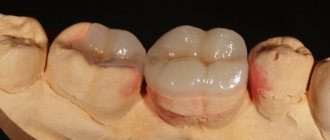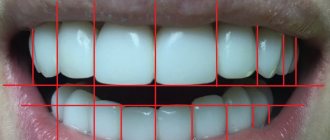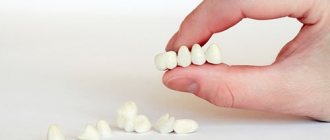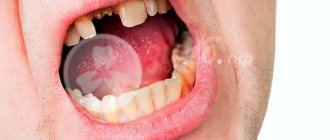Composite onlays for teeth
Therapeutic, or composite, onlays for teeth are used in cases where the goal is to build up a badly damaged tooth, and not just improve aesthetics. For example, they can be used in case of severe chipping of the incisor (more than half the area) or in other cases when orthopedic veneers are simply useless due to the impossibility of their installation. Such dental overlays are made using the direct method, that is, immediately on the patient’s tooth, from composite materials, hence their name – composite veneers. Therapeutic overlays have a standard color range, so in some cases the patient cannot choose the appropriate shade. The advantage of this type of onlay is that the patient receives a visible result in one visit; in addition, the price of onlays for teeth made of a composite is significantly lower than classic ceramic veneers.
Advantages and disadvantages of different types of veneers
The advantage of artificial onlays is the flawless recreation of the color, strength and tactile characteristics of natural teeth without the possibility of them being damaged by caries. Porcelain and ceramic veneers have the best qualities, according to dentists and patients.
They better imitate the natural surface of enamel and transmit light well, making them look natural and beautiful. These pads have a long service life if a person adheres to good oral hygiene and does not consume certain foods without proper preparation.
Composite plates are considered less durable - if not properly cared for, they can fall off prematurely and become yellow. Acrylic is also used for a short time due to the low natural effect.
Overlays for crooked teeth
In some cases, dental onlays can be used to correct minor defects in the dentition. These include veneers, as their thickness allows you to hide imperfections. Overlays on teeth that are too thin, such as lumineers and ultraneers, will not cope with this task. You can use onlays for leveling only if the patient has a correct bite - installing such onlays on the teeth to solve the problem of correcting the bite will not bring any effect. They are helping:
- camouflage crooked teeth;
- correct too short teeth;
- get rid of a gummy smile (the problem is solved in combination with gum surgery);
- give a lifting effect to the cheekbones (when installing onlays on chewing teeth).
If significant adjustments are required, it is better to opt for ceramic onlays for teeth, as they are reliable and aesthetically pleasing. Composite veneers can be used to correct minor defects. The price of such dental overlays is significantly lower than the cost of ceramic veneers.
In addition to veneers, if teeth are slightly crowded, crowns can also be used - they help correct the curvature of one or more teeth. The disadvantage of this method of installing onlays on crooked teeth is the need to prepare healthy dental tissues, which not every patient will do. This method is considered quite aggressive. The advantages include quick results, in contrast to using a braces system.
Types of dental inlays and their scope of application
Article navigation
- What are Tabs
- Stump and restorative
- Differences from a filling
- Differences from veneers
- Indications for use
- Contraindications
- Advantages
- What are the disadvantages
- Varieties and materials
- Manufacturing and installation
- Quality assessment parameters
- Are there any complications?
- Service life and care
- What to consider when choosing
- Current prices
Question for a specialist
Destruction of chewing teeth is a big problem for modern adults. Dietary features, the predominance of soft and sweet foods in the diet, and not always high-quality treatment of caries lead to the need for orthopedic restoration. One of the preferred methods is an inlay on the tooth, which will give it beauty and functionality for many years. Next, we will talk about what it is - an inlay for tooth restoration, what it looks like and what it is made of, how it is made, how it is placed and how much it costs.
Teeth onlays to correct bite
If the patient has no complaints about the enamel and is only interested in correcting crowded teeth, the doctor may suggest treatment with special mouthguards or aligners. Unlike fixed orthodontic structures, they can be removed during meals and during oral hygiene procedures. They are practically invisible on the teeth, as they are made of transparent material. Due to their tight fit to the dentition, removable onlays promote gradual teeth alignment. The disadvantage of treatment with mouthguards is their limited effect. If you have a complex case, then it is better to opt for aligners, which are as effective as braces.
Indications for installation
Veneers are used for a variety of purposes, but all patients expect the opportunity to have a dazzling smile without worrying about the unaesthetic appearance of their natural teeth. Dentists recommend the use of veneers in the following cases:
- Persistent staining of tooth enamel that cannot be whitened in people who smoke and often eat foods with coloring pigments.
- Presence of fluorescent spots. Old fillings placed on the anterior labial surface that have changed color.
- Rough edges, cracked or chipped teeth due to trauma, various types of mechanical damage. In these cases, therapeutic veneers are made.
- Crowding of the front teeth. Slight irregularities, too narrow, large or short teeth.
- Diastemas and tremas are spaces between teeth in different places of the upper and lower dentition.
- Brittle teeth and increased sensitivity to hot and cold foods.
- The patient’s desire to restore worn teeth in the most gentle way.
Often, veneers are made for 6-8 front teeth, and the rest are whitened or prepared for the installation of a bridge or implants. It is important to remember that the use of artificial plates is only a cosmetic technique, before which it is necessary to undergo treatment for caries and other inflammatory diseases of the oral cavity.
Aesthetic onlays for teeth
By “Hollywood” we mean a snow-white, even smile, which is associated with the smiles of movie stars - the generally accepted standard is four front teeth that are level with each other. In this case, the teeth must be large enough. In Russia, this concept simply means straight and white teeth. A similar result can be achieved in various ways. If, due to aesthetic defects, increased sensitivity or slight curvature of teeth, it is not possible to limit yourself to minimally invasive procedures, then cosmetic dental veneers are used. In aesthetic dentistry the following are used: veneers, ultraneers, compositers and lumineers. All of these types of aesthetic dental onlays are made in a dental laboratory using individual impressions of the patient’s teeth and then attached to the enamel surface.
In order to improve the aesthetics of the dentition, including hiding minor defects in the surface of the teeth, ceramic dental veneers are most often used, since this material is closest to the natural tooth enamel. The peculiarity of installing such onlays on teeth is that the procedure requires preliminary grinding of the enamel to the thickness of the veneer (0.3 - 0.7 mm). In addition, vinyl overlays for teeth are often used today; they are somewhat inferior to ceramic veneers in terms of characteristics, but are more affordable in cost. The number of plates installed may vary depending on the width of the smile. In cases where the teeth are severely damaged (less than 10% of the tissue remains) or there is a slight curvature of the dentition, crowns are used to achieve a Hollywood smile.
To achieve maximum strength, veneers are made of zirconium dioxide or aluminum (only the frame is made of metal, and the upper crown is made of ceramic), but in this case, the onlays on the teeth do not transmit light as well, so upon close examination the difference may be noticeable. In this regard, it is worth making an informed decision: either ceramic veneers for 5–8 years, or zirconium veneers for 15–20 years.
What is a tab
Veneers are used to restore the beauty of the front teeth and strengthen them.
Stump tab
used to strengthen molars. More often it is a mini-prosthesis that completely repeats the shape of the internal destroyed part of the crown. It is inserted into the tooth and secured with a special dental compound.
Such structures are a good way to restore a tooth. The inlay is used when the destruction of the natural crown exceeds 30% and there is a healthy root.
Their service life is 20 years or more, the materials tolerate chewing loads and correspond to the anatomical structure of the tooth. Their shade remains unchanged under the influence of food coloring. There are options:
- Restorative
, their role is close to the function of a filling. They are attached to the top of the unit without touching the channels. - Stump mini-prostheses
. Such a frame is fixed in the channel. Then the tooth is covered with a crown. A post-core inlay can help if the visible part of the tooth has crumbled and only the root remains.
Metal-free tab
– restoration of the dental crown, which is orthopedically justified and aesthetically pleasing. The surface wears out synchronously with the enamel, without any discomfort.
White teeth whitening pads
If the goal is only to change the shade of the enamel, dentistry uses the thinnest white overlays on teeth made of composite, as well as in the form of lumineers and ultraneers. Teeth whitening with onlays in this way is suitable only for those who have healthy enamel (or is slightly damaged). The lightening procedure itself using such plates is called restoration bleaching. It is used when traditional types of whitening, such as home, laser, oxygen and Zoom whitening, do not work. During installation, the onlays are attached to the facial surface of the front teeth. Whitening plates are not installed on chewing teeth.
If desired, the patient can always contact the doctor with a request to change the plates to new ones (of a different color) or remove them completely. Moreover, the cost of installing such onlays on teeth will be significantly lower compared to other types of restoration.
Care and possible problems
If the doctor does not follow the microprosthetics technique, veneers can quickly come off, change shade, do not fit in shape/size, and darkening occurs at the segments of the joints of the plate and the tooth. After deciding to install the product, it is recommended to choose a good clinic for treatment that has modern equipment and highly qualified specialists, since the duration of operation and the result of the work directly depend on the quality of the prosthesis and the professionalism of the dentist.
After the procedure, sometimes minor irritation, increased sensitivity, and redness of the gum mucosa occur - this is normal. Subsequent care involves the use of pastes with a low content of abrasive components, a soft brush, and an irrigator.
The durability of the plates depends on several factors - the material of the prosthesis and its manufacturing technology, the quality of installation, and proper hygiene. The main rule is that the patient must remember that he has artificial structures installed that need special attention:
- doctors recommend brushing your teeth twice a day, using a soft brush, a paste with a minimal abrasive content, and floss to remove plaque in hard-to-reach areas;
- It is forbidden to chew hard foods: seeds, nuts, candies. This may cause the product to break;
- it is necessary to avoid intense stress when chewing food, biting, blows to the jaw segment with fixed pads, reduce the consumption of coloring products - beets, red wine, strong tea;
- It is recommended to visit your dentist twice a year for professional cleaning.
If roughness/gaps occur at the attachment site, a chipped part of the restoration, signs of caries, mobility of the prosthesis, or pain, you must consult a doctor who will polish or correct the damaged structure.
Technique for installing onlays for restorative bleaching
Straight
– application of onlays on teeth made of composite material occurs directly on the enamel without preliminary production in the laboratory.
Indirect
– the thinnest (up to 0.3 mm) dental overlays are attached to the teeth – lumineers and ultraneers, pre-made in the laboratory individually based on a dental impression.
In addition to the listed methods, you can lighten the enamel by several shades using removable trays, which are used for whitening at home. They work due to a special whitening gel placed in the plate. You need to wear them for an average of an hour a day. But, unlike lumineers or composite veneers, it is not possible to accurately “predict” the result in advance, since it depends on the individual characteristics of the patient.
Current prices for microprostheses
How much does a ceramic inlay cost for a tooth? The cost of microprostheses depends on the materials, their quality, the complexity of manufacturing, the qualifications of the orthopedist, dental technician and the equipment of the dental laboratory. The table below shows current prices for different types of microprostheses.
- Fishchev S.B., Sukharev M.V., “Ceramic dental inlays and vestibular veneers” / SpetsLit, 2022 – 119 p.
Author: Sambuev B. S. (Thank you for your help in writing the article and the information provided)
Jewelry on teeth
When your teeth are healthy, but you still want your smile to attract even more attention from others, patients turn to aesthetic dentistry to have onlays placed on their teeth for beauty: skys and grills.
Skyes
– decorative overlays on teeth, which are used to decorate the enamel or camouflage a small defect. These can be gold and silver overlays for teeth, as well as platinum and combined ones - using crystal, Swarovski crystals and precious stones.
Skyce installation is carried out using two methods. The first involves attaching the onlay directly to the tooth: a depression is made on the surface of the tooth, and the stone is fixed in it using a composite material. But inlay is a rare occurrence in dentistry, since not everyone wants to have an extra hole in a healthy tooth. In the second case, microprosthetics is used: the skye is installed on an onlay (veneer), previously made from an impression, then the onlay is attached to the tooth surface using filling materials. Such dental overlays help hide more serious enamel defects.
Grillz
– removable dental onlays, which are installed on both one and several front teeth. They are popular among celebrities and are usually quite expensive because they are custom-made from precious metals. Silver, gold and platinum dental overlays can be encrusted with diamonds, emeralds and rubies. However, grillz do not necessarily have to be made of gold or other precious metals. They can be made from inexpensive metals with rhinestones and not individually, but according to a template. In this case, the price for such dental overlays will be more affordable.
The difference between an inlay and an onlay from a regular filling
Advantages of inlays and onlays over composite fillings
Accuracy
Durability
Aesthetics
Dental health in the future
Correct bite
Accuracy
An inlay or onlay is made using computer modeling, which means it reconstructs the tooth as accurately as possible.
Durability
The insert is more resistant to abrasion and lasts much longer.
Aesthetics
There is no loss of fit in the area of the inlay or onlay because the adhesion between the structure and your tooth is much stronger. This means that the border between the restoration and the tooth is absolutely invisible.
Dental health in the future
When inlays are created in the laboratory, their function is tested in an articulator (a special device that simulates the movement of the patient's jaws). Thus, the technician in the laboratory has the opportunity to restore all the lost cusps and fully restore the contacts that should be with the teeth of the opposite jaw. This ensures proper closure and prevents premature tooth wear.
Correct bite
Due to the strength of the material, which does not shrink, there is no cavity between the tooth and the restoration in which repeated caries can develop.
Tooth restoration using a composite filling
- The therapist models the filling directly in the oral cavity. His task is complicated by the presence of soft tissues, the presence of fluid in the mouth, the patient’s ability to lie with his mouth open, and limited time.
- A general practitioner does not have the conditions to accurately restore the anatomy of a tooth, which are available in a technical laboratory. During therapeutic tooth restoration, it is not possible to completely restore the relief and all the tubercles.
- The therapist is forced to do his work by eye, which does not give an entirely accurate result.
- In the future, the filling material, even if we hypothetically assume that everything is very accurately restored, will wear out over time.
- Perhaps the most important thing is when there is little tooth tissue left, and we restore them with filling material, then there is a possibility of the walls breaking off because sooner or later a violation of the fit will occur in the area between your tooth and the filling. Over time, the wall may break off.
Fabrication of prosthetic restorations in the laboratory
Composite restoration in the dentist's chair
How to put on perfect smile pads correctly?
Having purchased a new product, first of all you need to read the instructions on how to install Perfect Smile veneers. It is extremely important to follow clear instructions to avoid improper placement of the overlays on your teeth and gums, as well as any discomfort.
We invite you to familiarize yourself with Bitter taste in the mouth: causes, symptoms, diagnosis, treatment | Competently about health on iLive
Instructions for use of Perfect Smile Veneers:
- Preparation - place the plates in a glass of hot water for several minutes until the white coating becomes transparent;
- Shaping - we firmly press the veneers to the natural teeth to obtain the required outline of the plate;
- Hardening - immerse the veneers in cold water for a few minutes until the white coating reappears;
- Installation - we put on the plates like ordinary plug-in elements.
The versatility of Perfect Smile Veneers lies in the ability to shape the onlays identical to natural teeth.
Only with proper preparation will Perfect Smile veneers last a long time, will not cause inconvenience and wear well: they do not fall out and do not interfere with talking or eating.
Many buyers complain about the poor quality of the product, not knowing how to use veneers correctly. Therefore, we recommend watching a video on how to put on Perfect Smile Veneers:
The importance of following recommendations for installation and operation of overlays is sometimes underestimated. The quality of your future smile depends on the correct preparation and placement of the plates. Placing veneers according to the rules allows you to avoid possible difficulties and save time before an important event.
Instructions for use
In addition to the installation instructions, it is necessary to take into account the manufacturer's instructions for using the Perfect Smile Veneers design. It is important to store the product correctly and promptly clean it from food residues.
We suggest you read: Runny nose and cough on teeth in a child
Basic rules when using Perfect Smile Veneers:
- The pads must be stored in a special container included with the product;
- The plates should be washed regularly for cleaning and disinfection;
- It is better to soften the veneers and give them shape immediately before installation;
- It is not recommended to attempt to use the pads for purposes other than their intended purpose;
- The plates must not be broken, bent or subjected to other traumatic effects.
When used correctly, Perfect Smile Veneers can last for many years and will not require immediate replacement.
You can wear veneers throughout the day, but at night it is recommended to remove them and wash them.
The product should be washed according to the manufacturer's instructions:
- Perfect Smile Veneers can only be washed in warm water;
- It is not recommended to use soap substances intended for hair and body;
- You should not use devices with solid particles, for example, scrubs, toothbrushes, especially with hard bristles;
- Avoid using chemicals;
- It is better to rinse the plates under running water;
- The product should dry naturally.
The best way to clean veneers is to use warm water and baking soda; you can also use toothpaste or powder, but apply them with your finger. After the procedure, the plates should be lightly blotted with a towel and left to dry in a well-ventilated area.



